#Falcatakely forsterae
Photo

Modern birds' upper beaks are made up mostly from skull bones called the premaxilla, but the snouts of their earlier non-avian dinosaur ancestors were instead formed by large maxilla bones.
And Falcatakely forsterae here had a very unusual combination of these features.
Living in Madagascar during the Late Cretaceous, about 70-66 million years ago, it was around 40cm long (1'4") and was part of a diverse lineage of Mesozoic birds known as enantiornitheans. These birds had claws on their wings and usually had toothy snouts instead of beaks, and many species also had ribbon-like display feathers on their tails instead of lift-generating fans.
Falcatakely had a long tall snout very similar in shape to a modern toucan, unlike any other known Mesozoic bird, with the surface texture of the bones indicating it was also covered by a keratinous beak. But despite this very "modern" face shape the bone arrangement was still much more similar to other enantiornitheans – there was a huge toothless maxilla making up the majority of the beak, with a small tooth-bearing premaxilla at the tip.
This suggests that there was more than one potential way for early birds to evolve modern-style beaks, and there may have been much more diversity in these animals' facial structures than previously thought.
———
Nix Illustration | Tumblr | Twitter | Patreon
#science illustration#paleontology#paleoart#palaeoblr#falcatakely#enantiornithes#opposite bird#avialae#bird#maniraptora#theropod#dinosaur#art#snootbird
1K notes
·
View notes
Text
Round Two: Caihong vs Falcatakely
Caihong juji

Artwork by @i-draws-dinosaurs, written by @i-draws-dinosaurs
Name meaning: Rainbow with big crest
Time: 161 million years old (Oxfordian stage of the Late Jurassic)
Location: Tiaojishan Formation, China
It’s always a special treat to hear the announcement of a dinosaur with known colours, because it gives the most direct impression of how truly stunning these animals would have been to witness in real life. And Caihong might just be the most spectacular of them all so far, described in 2018 from an immaculate full-body fossil that preserves detailed feathers! Caihong’s feathers are longer than some other floofy dinosaurs, and would have had the appearance of a luxurious mane along its neck. Not only that, the fossil preserves feather microstructures that in life would have made this dinosaur gloriously iridescent!
Now iridescent dinosaurs aren’t new, Microraptor has been decked out in fabulous starling-esque plumage for a while now, but Caihong absolutely takes it to the next level. Its whole body was covered in iridescent black, including the enormous tail, but the real star of the show are the platelet-like melanosomes found on the head, neck, and the base of the tail. Different from the usual iridescent melanosomes, the structure of these tiny organelles reflects brilliantly iridescent colours, like those on the heads of hummingbirds and particularly the bright purple feathers on the necks of the trumpeter family. Caihong would have put on an absolutely dazzling jewel-toned display in the treetops or on the forest floor of prehistoric China!
Falcatakely forsterae

Artwork by @otussketching, written by @zygodactylus
Name Meaning: Forster’s Small Scythe Beak
Time: 70 to 66 million years ago (Maastrichtian stage of the Late Cretaceous)
Location: Maevarano Formation, Mahajanga Province, Madagascar
We like to joke that the different types of protobirds in the Mesozoic were just like modern birds with teeth, and that’s obviously an oversimplification, but sometimes it’s just true. This is one of those times. Falcatakely was an Enantironithine - an Opposite bird - very distinct from living birds, and yet, it convergently evolved a toucan beak, essentially rendering it a toothed toucan! Don’t get your hopes up, though - the teeth were few in number, concentrated in the front of the beak. But, still, that’s not going to stop me from calling this an Opposite Toucan. Unfortunately, only the skull is known, so it is uncertain how large the rest of the body was - the beak itself was 9 centimeters in length. Falcatakely lived in the seasonally arid Maevarano Formation, which transitioned between a swampy floodplain and a semidesert depending on the season. Here there were a LOT of weird animals, not just Falcatakely - this is the home of the herbivorous croc Simosuchus, the toothy dinosaur Masiakasaurus, giant stem-mammals like Adalatherium, the giant frog Beelzebufo, the weird protobird Rahonavis, and more normal things like Majungasaurus and Rapetosaurus. Honestly, we should stop being surprised at the strange things islands manage to produce, but I’m not quite ready to give up that shocked feeling yet.
#dmm#dmm rising stars#dinosaur march madness#dinosaurs#birds#dmm round two#birblr#palaeoblr#paleontology#bracket#march madness#polls#caihong#falcatakely
148 notes
·
View notes
Photo

I finally got around to painting!
This is Falcatakely, a weird mesozoic bird from the late Cretaceous of Madagascar! I shouldn’t have been surprised that something weird was found from an island environment, but the fact that this animal was quite odd and the fact that it’s a bird is so cool! Falcatakely is notable because of its large, toucan-bill shaped snout. And it’s known from only a skull, so we don’t knkow what the rest of it looked like. It was probably about the size of a crow, however.
I have to note, though. There is a lot of debate whether or not this animal was a bird. The authors say it’s an opposite bird, or enantiornithine, but others are not convinced. Some say it’s a more basal bird or even a dromaeosaur. So we have to wait some more data on that front.
Little anecdote, I spilled water on this accidentally as I was painting it. Fortunately, this is a gouache painting, so I was able to salvage it. Turned out ok, I think.
#paleoart#palaeornithology#palaeoblr#falcatakely forsterae#gouache#mesozoic#madagascar#extinct bird#birblr
441 notes
·
View notes
Photo


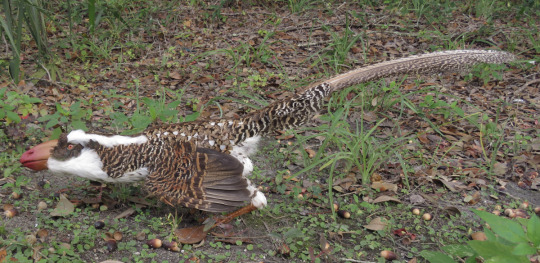
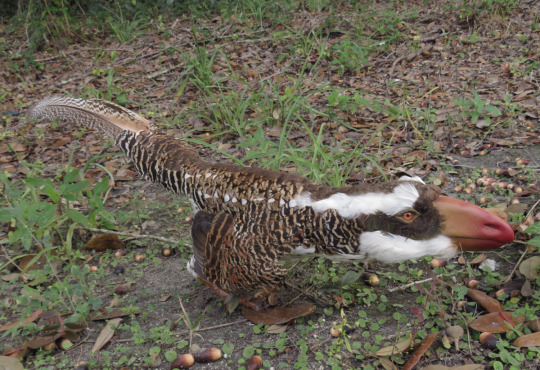

Falcatakely, made of peacock, pheasant, grouse, and chicken feathers
This one has a process vid of making it: https://youtu.be/6GiNrQqt2TM
313 notes
·
View notes
Text

quick drawing of Falcatakely forsterae, a new enantiornithine bird with a large tall bill similar in shape to a toucan. I gave it a similarly large lower bill since we only know of the upper cranium and It seems like everyone saw the "its like a toucan!" and then didn't go any further with speculation lol
#fraizer draws#palaeontology#paleontology#paleoart#palaeoart#birds#bird#dinosaur#extinct#art#Falcatakely forsterae#falcatakely#extinct bird
292 notes
·
View notes
Text


I wanted to draw some of the recently described dinosaurs in my Archovember style since they weren’t released when I did Archovember and I probably won’t be adding them to next year’s list but I still thought they were cool enough to make some art of them (and stickers)
First is the enantiornithine bird Falcatakely forsterae, a tiny lil bird from Cretaceous Madagascar with a big ol beak. I started off making it look like a pied crow, then realized that the skull would have only been 3 inches long, so I made it much slimmer and gave it some more “small jungle bird” type colors.
Second is Ubirajara jubatus, a small compsognathid that was (illegally) smuggled out of Brazil in 1995 and was just recently finally published. It was interesting because it had at least two long, stiff filamentous structures coming from its shoulders, similar to the Standardwing bird-of-paradise. It also had a mane of fuzzy proto-feathers running along it’s back. These features probably would normally lay flat against the animal and be puffed out only for display.
Ubirajara is also the subject of much debate, as the nature of its removal from Brazil was shady at best and, since 1990, it has remained illegal to remove any Brazilian fossils from Brazil, and to not have at least one Brazilian paleontologist on the team when assessing the fossil. The authors of the paper on Ubirajara, specifically David Martill, have scoffed at these laws and made some bordering-on-racist comments in their refusal to return the fossil.
#my art#SaritaDrawsPalaeo#Falcatakely forsterae#Falcatakely#birds#theropods#dinosaurs#Ubirajara jubatus#Ubirajara#UbirajaraBelongsToBr
22 notes
·
View notes
Link
3 notes
·
View notes
Text
Strange Toothed "Toucan" Was Friends With Dinosaurs
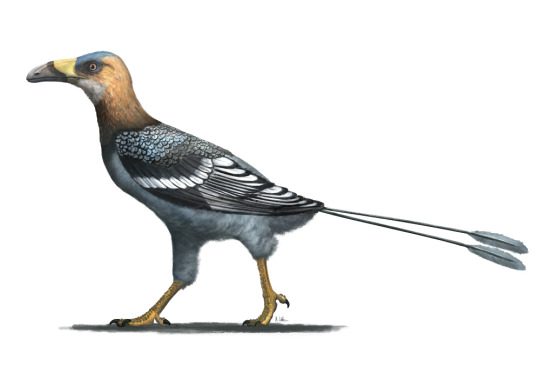
A creature described as resembling a "buck-toothed toucan" that lived some 68 million years ago in (what is now) Madagascar has recently been discovered thanks to its fossilized remains. It was small, just 3.5 inches (9 cm) long. But it is outsized in its importance.
The tall, scythe-like beak, while resembling the toucan, is something never before seen in the fossil record for the Mesozoic. Birds in the Mesozoic did not have specialized beaks. Or at least, it was thought they did not, until Falcatakely forsterae was found.
317 notes
·
View notes
Link
A bizarre bird from the Mesozoic Era had a small, scythe-like beak with one tooth at its tip. Its fossil was found in Madagascar and hints at a lost world of ancient birds that paleontologists are only just starting to uncover.
Measuring less than 9 centimetres and sporting a curved, deep bill, the bird would have looked a bit like a tiny toucan. “When I first saw a photo of the skull, I thought I was looking at a modern-day toucan that was somehow encased in concrete,” says Steven Brusatte at the University of Edinburgh in the UK, who wasn’t involved in the study of the fossil.
The skull of this bird, called Falcatakely forsterae, was preserved in rock between 66 and 72 million years ago.
Continue Reading.
320 notes
·
View notes
Text




اكتشف علماء الأحافير حفريات لطائر قديم في مدغشقر بمنقار يشبه منقار الطوقان أو أبو قرن.
عاشت هذه الأنواع، التي يطلق عليها اسم Falcatakely forsterae ، في نهاية عصر الديناصورات وتنتمي إلى جنس الطيور يسمى بـ enanciornis ، وهي مجموعة من الطيور التي هيمنت على العصر الطباشيري ولكنها لم تنجُ من الانقراض الجماعي منذ حوالي 65 مليون سنة.
يوسع الاكتشاف الجديد فهم العلماء لتنوع طيور العصر الوسيط
14 notes
·
View notes
Text
Falcatakely vs Janavis

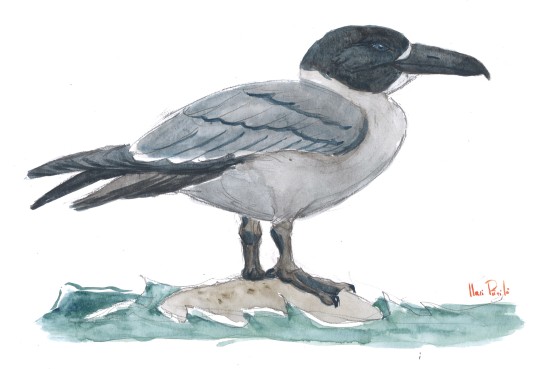
Factfiles:
Falcatakely forsterae

Artwork by @otussketching, written by @zygodactylus
Name Meaning: Forster’s Small Scythe Beak
Time: 70 to 66 million years ago (Maastrichtian stage of the Late Cretaceous)
Location: Maevarano Formation, Mahajanga Province, Madagascar
We like to joke that the different types of protobirds in the Mesozoic were just like modern birds with teeth, and that’s obviously an oversimplification, but sometimes it’s just true. This is one of those times. Falcatakely was an Enantironithine - an Opposite bird - very distinct from living birds, and yet, it convergently evolved a toucan beak, essentially rendering it a toothed toucan! Don’t get your hopes up, though - the teeth were few in number, concentrated in the front of the beak. But, still, that’s not going to stop me from calling this an Opposite Toucan. Unfortunately, only the skull is known, so it is uncertain how large the rest of the body was - the beak itself was 9 centimeters in length. Falcatakely lived in the seasonally arid Maevarano Formation, which transitioned between a swampy floodplain and a semidesert depending on the season. Here there were a LOT of weird animals, not just Falcatakely - this is the home of the herbivorous croc Simosuchus, the toothy dinosaur Masiakasaurus, giant stem-mammals like Adalatherium, the giant frog Beelzebufo, the weird protobird Rahonavis, and more normal things like Majungasaurus and Rapetosaurus. Honestly, we should stop being surprised at the strange things islands manage to produce, but I’m not quite ready to give up that shocked feeling yet.
Janavis finalidens

Artwork by @otussketching, written by @zygodactylus
Name Meaning: Janus’ final toothed bird
Time: 66.8 million years ago (Maastrichtian stage of the Late Cretaceous)
Location: Maastricht Formation, Eben-Emael, Belgium
Janavis was another inhabitant of the Maastricht Formation, living alongside the modern bird Asteriornis, which it would have appeared very similar to - except Janavis was a protobird, specifically a cousin of Ichthyornis, featuring teeth (like other protobirds) and serving as an interesting juxtaposition living alongside Asteriornis - a strange play of the past and the future, living alongside one another, just before the asteroid hit. Janavis is known from fossils embedded in hard rock that were primarily examined via CT scan, which revealed vertebrae and parts of the limb bones, where only the skull and some fragments had been known previously from the exposed parts of the fossil. Fairly large, with a wingspan of five feet, it was much bigger (nearly twice) than its cousin Ichthyornis. It had greatly pneumatisied vertebrae, and a very kinetic skull allowing for a wide variety of movement in the jaws. This is interesting, as the earliest derived modern birds - the Paleognathes - all have non-kinetic skulls like most dinosaurs, indicating that it is possible that group had a trait reversal, rather than kinetic skulls only first evolving in Neognathes. It mainly fed on seafood along the coast, like its relatives, and spent its time in the tropical forests along the coast. Many invertebrates, ammonites, corals, echinoderms, sharks, mosasurs, turtles, elasmosaurs, and marsupials shared its environment, as well as dinosaurs such as Asteriornis, Orthomerus, and as-yet unnamed taxa.
DMM Round One Masterpost
#dmm#dinosaur march madness#dinosaurs#dmm round one#dmm rising stars#palaeoblr#paleontology#march madness#polls#bracket#falcatakely#janavis
136 notes
·
View notes
Photo
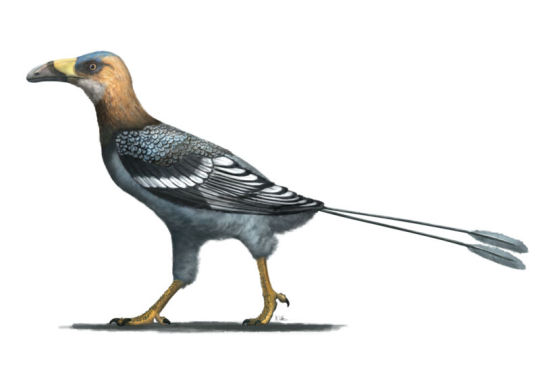
Surprising Cretaceous bird fossil has toucan-like beak Enlarge / Artist's depiction of Falcatakely forsterae. (credit: Mark Witton) Given the unusual attention granted to turkeys this week, let’s talk dinosaurs.
0 notes
Text
Fossil reveals weird, toothed 'toucan' that lived alongside the dinosaurs
https://sciencespies.com/nature/fossil-reveals-weird-toothed-toucan-that-lived-alongside-the-dinosaurs/
Fossil reveals weird, toothed 'toucan' that lived alongside the dinosaurs
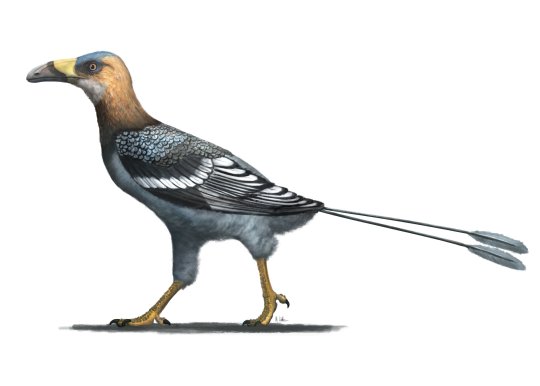
The discovery of a creature described as resembling a “buck-toothed toucan” that lived some 68 million years ago has upended assumptions about diversity in the birds that lived alongside dinosaurs.
At less than nine centimetres (3.5 inches) long, the delicate skull of the bird scientists have dubbed Falcatakely forsterae might be easily overlooked.
In fact, it almost was, sitting in a backlog of excavated fossils for years before CT scanning suggested the specimen deserved more attention.
It turns out that its tall, scythe-like beak, while resembling the toucan, is something never before seen in the fossil record.

Artist reconstruction of Falcatakely forsterae. (Mark Witton)
Birds in the Mesozoic era – between 250 million and 65 million years ago – had “relatively unspecialised snouts”, Patrick O’Connor, lead author of a study on the new creature, told AFP.
“Falcatakely just changed the game completely, documenting a long, high beak unlike anything known in the Mesozoic,” added O’Connor, professor of anatomy and neuroscience at Ohio University.
The skull, described in a study published Wednesday in the journal Nature, offered other surprises.
While Falcatakely would have had a face quite familiar to us from such modern birds as toucans and hornbills, the bones that made up its face bear little resemblance to those modern creatures.

The fossilised skull of Falcatakely forsterae. (O’Connor et al., Nature, 2020)
“Despite an overall face shape similar to modern birds like toucans, the underlying skeleton is much more similar to non-avian theropod dinosaurs like Deinonychus and Velociraptor,” O’Connor said.
That “turns what we know about Mesozoic bird anatomy upside-down.”
‘An almost comical profile’
Revealing these features was no easy task.
The fossil was originally collected in 2010 in northwestern Madagascar.
When researchers finally turned their attention to it seven years later, they faced a problem: the skull and beak were far too fragile to extract for examination.
So the team used a form of high-resolution imaging and digital modelling to “virtually dissect” the bones.
They then used 3D printers to rebuild the skull and compare it with other known species.
What they found was an almost touchingly improbable animal, according to Daniel Field, of Cambridge University’s department of earth sciences, who reviewed the study for Nature.
It is not just the unexpected bill, but the fact that the beak in the fossil is tipped with a single preserved tooth, possibly one of many the bird would have had.
“These features give the skull of Falcatakely an almost comical profile – imagine a creature resembling a tiny, buck-toothed toucan,” Field wrote.
None of the approximately 200 bird species known from the period “has a skull resembling anything like Falcatakely”, he added.
For O’Connor, the discovery is evidence of the potentially enormous gaps that remain in our knowledge of the birds that lived alongside dinosaurs.
“There is a span exceeding 50 million years where we know next to nothing about avian evolutionary history,” he said.
Finding intact fossils of birds from the period is comparatively rare because their lightweight skeletons were generally too delicate to be well preserved.
The research team, which has been working in the area of Madagascar where Falcatakely was found since the mid-1990s, is continuing excavations, and O’Connor is excited about what else might be discovered.
He also hopes to explore just why Falcatakely had the beak it did.
“Did it relate to processing food? Acquiring prey? Was it used as a signal by other members of the species? There are many questions left,” O’Connor said.
© Agence France-Presse
#Nature
0 notes